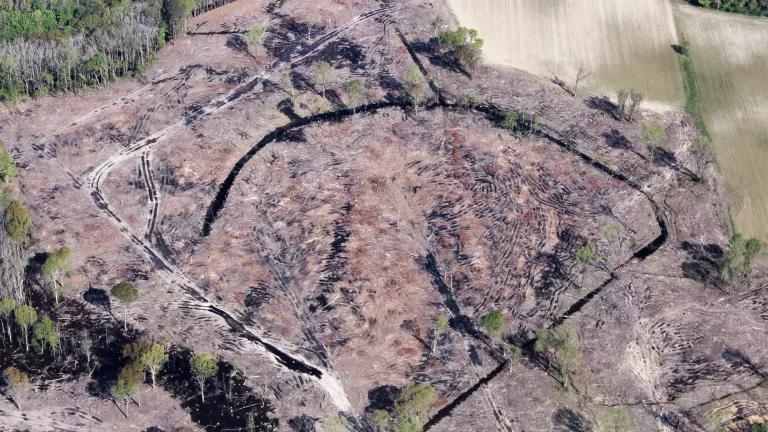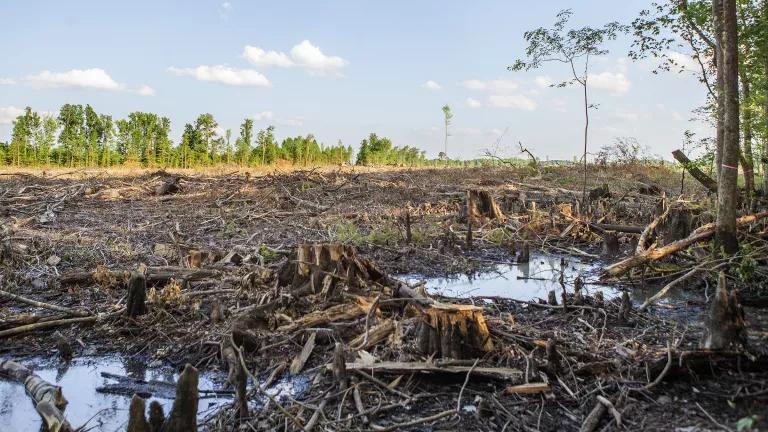What the New Global Biodiversity Deal Means for Bioenergy
Three key takeaways from the 15th meeting of the Parties to the Convention on Biological Diversity (CBD).

Delegates applaud the adoption of the Kunming-Montreal Global Biodiversity Framework (GBF) at the 15th UN Biodiversity Conference.
Julian Haber/UN Biodiversity
2022 ended with a brand new global deal to save nature at the 15th meeting of the Parties to the Convention on Biological Diversity (CBD), where the Parties agreed to halt and reverse the loss of nature, or "biodiversity," by 2030.
Even as the summit opened, hundreds of scientists were ringing the alarm bell about a major threat to forests and wildlife: bioenergy. Over 700 scientists signed a letter warning of the impacts of this industry - which involves burning trees from forests.
Forests are one of the planet's most critical types of habitat. But more and more countries that are cutting out coal are burning trees in power stations to create energy--a process that emits just as much carbon at the smokestack as coal, along with producing additional emissions at every step of the process.
The climate impacts of bioenergy are well covered elsewhere by colleagues of mine. But bioenergy also poses a major risk to biodiversity. According to some estimates, the global demand for wood pellets - the fuel that is burned in power stations - could double from 14 million tonnes in 2017 to 36 million tonnes in 2027. And in 2021, a single UK power station burned around 8 million tonnes of wood, around half of which came from forests (much of the rest was sawdust from sawmills). The wood from forests probably involved the logging of around 45,000 hectares - a little bit more than the size of the Isle of Wight. By 2027 global demand, every year, could be almost five times this.
A blog by my colleagues covers what NRDC was hoping for from the summit. Here are 3 key takeaways about what the Convention means for bioenergy.

Southern Resident killer whales swimming off Saturna Island in Canada
Miles Ritter via Flickr, CC BY-NC-ND 4.0
Protecting 30% of land (and seas)
The most notable outcome of the Convention was that Parties agreed to halt and reverse biodiversity loss by protecting 30% of the world’s lands and seas by 2030. This is good news for the planet, and for stopping bioenergy since the forests being logged for biomass (some of which are in protected areas) will be some of the areas countries count first towards their 30x30 commitments. The problem is that despite advocacy from Blue Leaders and other countries, the CBD Parties failed to include language setting forth what level of protection is required for 30x30 areas. While NRDC and others pushed for this target to include “fully and highly” language for protected ocean areas and “prohibit environmentally damaging activities” for both ocean and land areas, this language wasn’t agreed to. The language that WAS included – requiring that 30x30 areas be “effectively conserved” is far too ambiguous to ensure that activities like biomass logging don’t occur in areas that are counted towards 30x30. And Canada is already saying that they will allow some resource extraction in 30x30 areas.

A prairie warbler perched in a cedar
Jason Ondreicka/iStock
Stopping wildlife loss
"Bioenergy logging is a driver of habitat destruction and species loss in and around the forests it fells for wood pellets."
Target 4 of the new deal says that Parties will “ensure urgent management actions to halt human induced extinction of known threatened species and for the recovery and conservation of species…” While NRDC and CBD Parties unsuccessfully attempted to make this language even stronger at CBD by, for example, adding the word “immediately,” the end result could still help stymie bioenergy to some degree. That’s because bioenergy logging is a driver of habitat destruction and species loss in and around the forests it fells for wood pellets, including imperiled species. For example:
- In the southeast United States, forests in a Global Biodiversity Hotspot are logged to supply the wood pellet industry. This is putting many species of birds - that are already critically endangered, endangered, or vulnerable - at greater risk.
- In Estonia, the bioenergy industry has sourced pellets from Natura 2000 nature reserves - which are supposed to be legally protected because of their importance for rare and threatened wildlife. For example, the logging industry has disturbed rare breeding birds like goshawks, and woodlands that are home to endangered species like the red-breasted flycatcher.
- In Canada, logging of trees for wood pellets has contributed to increasing fragmentation of forests that is causing dwindling numbers of threatened species like the woodland caribou.

The biomass- and coal-fired Drax Power Station in Yorkshire, England
Neil Mitchell/Shutterstock
Reducing financial subsidies that harm nature
The new global nature deal also increases funds for nature protection and phases out and eliminates government subsidies or grants that harm nature by $500 billion every year. This could be helpful to fighting bioenergy, but the devil will be in the details. That’s because while bioenergy both harms nature and receives billions in subsidies each year, it has been mistakenly classified as a renewable and low-carbon technology and thus may not be “reduce[d] and eliminate[d]” under this deal. That would be incredibly unfortunate, especially given the size of the subsidies we’re talking about. Across the UK and nine other European countries 2021 subsidies to the bioenergy industry totalled over £5 billion. As my colleague wrote, if it were redirected to help nature, instead of destroying it, this money could make a difference to the $600-800 billion annual biodiversity funding gap experts estimate. And there’s no end in sight. Because bioenergy’s biggest cost is the fuel it buys (i.e., wood pellets), subsidies won’t help make it financially independent in the long-term and there’s little likelihood bioenergy would ever be able to survive without subsidies. The bottom line is that biomass subsidies must be counted as subsidies that harm biodiversity, and included as an indicator in the deal’s monitoring framework, which is still being developed.




